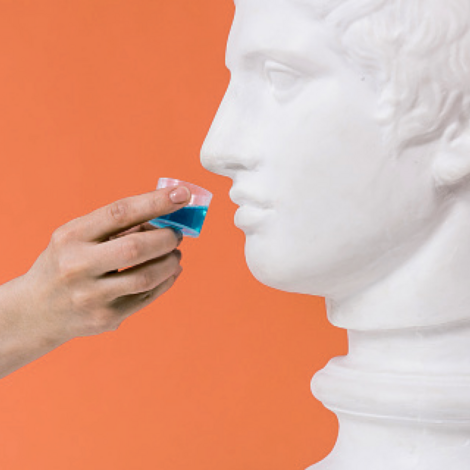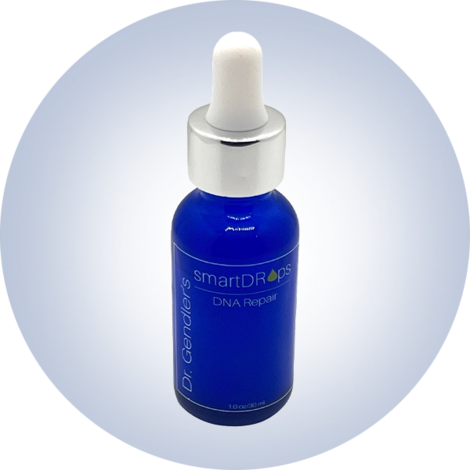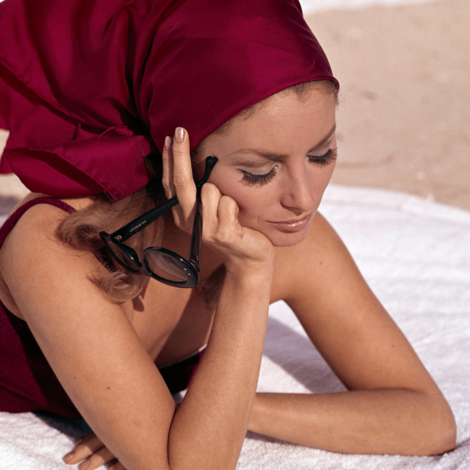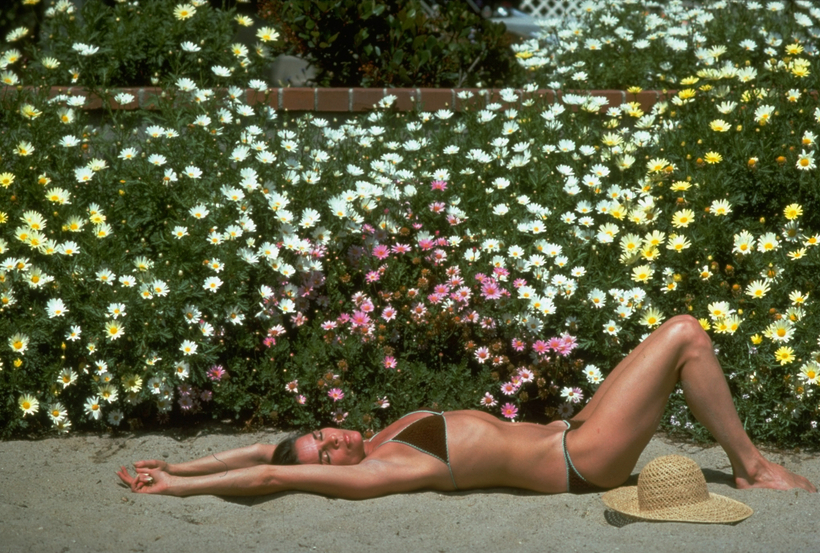For years, the sun was just plain gauche.
Its demonic cousin, the tanning bed, was even worse, a relic tucked away in the back of strip malls, still humming with fluorescent defiance while the rest of the world slathered itself in SPF 50. Sunscreen even became sexy (hello Supergoop!), and a ghostly pallor was a virtue. To admit to using a tanning bed in post, jeez, 2010 was like lighting up a Marlboro in a spa.
But now, wildly popular new brands like Tanning Club (tagline: “Bronze responsibly,” whatever that means) and Vacation are romanticizing the suntan and selling products like hot tamales. Against all health advisories and logic, tanning is back, alongside Juicy Couture tracksuits, Diet Coke, and those Marlboros.
Scroll through TikTok or Instagram reels, and you’ll find bronzed 20-somethings captioning selfies with #tan and #tanningbed. Not just content with bronzers and self-tanners, a growing number are embracing the old-fashioned tanning salon and sun worship itself as a space of transformation—a therapy session lit with UV rays.
You can find tanning beds in the rec rooms and gyms of many universities. This is in 2025, when, according to the Skin Cancer Foundation, “worldwide, there are more skin cancer cases due to indoor tanning than there are lung cancer cases due to smoking.” The return of early-aughts culture isn’t new—Y2K nostalgia has been fueling fast fashion and music tastes for years—but this specific resurrection may tap into something deeper and more disturbing.
That’s because bathing in the sun and bed may be habit forming. In fact, in 2010, researchers began to notice that some people correlate tanning with psychological health. Alongside two colleagues, Dr. Shadi Kourosh, assistant professor of dermatology at Harvard Medical School and dermatologist at the Sadick Dermatology Group in NYC, published a research paper, “Tanning as a Behavioral Addiction,” that found that those who partake are aware of tanning’s inherent ills and still indulge for the endorphin rush usually associated with drugs and alcohol. “So, tanning in some people actually causes endorphins to rise,” says Dr. Kourosh. “Just like exercise and sex.”
The look today isn’t your early-2000s Snooki-style orange shellac. Gen Z, whose parents slathered them in daily sunscreen and fed them organic almonds, knows that the dermatologists are shaking their heads. And still, they do it. Why?
Myah Berkley, a 23-year-old Pennsylvania native, explains what she considers the “health benefits” of basting in a combination of sunscreen and tanning oil: “Being outside makes me feel really healthy. And visually speaking, having a tan also makes me look healthier. That’s a big confidence booster.”
Chloe Lucas, a recent graduate of James Madison University, says, “Honestly, [being tan] makes me feel better and more confident. In school, the winters are so long. I would go home over the holidays and eat and gain weight. So, I’m like, Cool, I’m checking pounds and pale right now, but I can fix one of these issues overnight.”
Therein lies part of the appeal: A tan is fast, visible, and low effort. It offers aesthetic control in a time of emotional chaos. And for this generation raised under the aesthetic halo of ring lights and the unforgiving scrutiny of HD front-facing cameras, visual confidence is currency.
There’s also the return of products that unapologetically promote tanning. Appearing bronze and golden is part of the Gen Z zeitgeist overall. They broadcast live TikToks from their tanning beds and offer instructions on how to use tanning products as face contour. (It’s fascinating enough to try: “You literally just put self-tanner on a makeup brush and go around the edges of your forehead and cheekbones where you would normally put bronzer,” says Lucas. “And you wake up, like, snatched.”) One popular line with Gen Z, Isle of Paradise, appeals to that sense of assurance and immediacy with the description for its bronzer: “Instant glow, instant results, instant confidence.”
In the same way that Gen Z and Alphas are attracted to vinyl records, brands like Vacation play on the nostalgia for Bain de Soleil and Coppertone’s visible bikini lines. But their homages contain SPF 30.
That’s not the case with Tanning Club, a new line dreamed up by a couple of surfer dudes from California. Like Vacation, the packaging hearkens to a ’70s vibe when people slathered themselves in baby oil and baked in the backyard. But Tanning Club sells products such as Royal Tanning Balm—kudos for the clever name—with absolutely zero SPF and nebulous “UV-absorbing botanicals.”
Tanning Club co-founder Will Anderson understands the critics of the brand and its tanning oils and lotions with SPFs ranging from 6 to 15, leaving dermatologists to shake their fists at the sunny sky. But when he noticed beach goers dipping into old-school tanning products, he saw, “no pun intended, the white space” and decided to make cleaner versions of staples like Hawaiian Tropic. “It’s not like we’re saying, go out and get torched and sunburned,” he explains. (For the record, they do sell a SPF 30 sunscreen, and he says there are plans to extend the line into mineral sunscreens.) “Just look at any coastline: when the sun’s out, people are out there tanning,” he explains. “And I’m like, let’s just create products for [them].”
Indeed, any dermatologist worth their sea salt would sound the alarm on this return to so-called innocence. There are degrees of sin: Lying out is bad enough, but “tanning beds are worse than the sun because they emit about three times the UVA than the sun. This type of UV light penetrates deeper than UVB [the “burning” rays],” says New York dermatologist Dr. Ellen Gendler.
She points out that teens tend to have an “it won’t happen to me” mentality. But the dangers are real: “The risks of developing all types of skin cancer are much greater if you started using tanning beds before the age of 35. And then there is the cosmetic side—those who use tanning beds develop more lentigines [brown spots] and chronic sun damage, leading to skin that appears leathery, worn, and wrinkled.” Hardly the mantle of robust health.
At the end of the day, and a dose of aloe vera later, some young people describe tanning as a quick aesthetic fix, but others explain the more emotional pull. Tanning beds offer not only warmth but a kind of sensory deprivation: lying still in a warm pod, disconnected from phones, flooded with light, and alone, safely off the phone and its constant notifications and bad news. Lounging in the sun offers a similar respite.
To dismiss the tanning bed resurgence as an act of vanity is to miss the cultural undercurrent. For Gen Z, whose formative years have been shaped by climate anxiety, pandemic isolation, and the rise of digitally mediated beauty standards, the tan isn’t just a look—it’s a tool of defiance, a nod to nostalgia, and maybe a cry for help in a digital-first world where AI threatens to remove us from reality. The sun, ironically, seems grounding.
Will the glow last? Probably not. Brat summer and Cottagecore came and went. But for now, under the unforgiving August rays and the flicker of UV bulbs, a new generation is wading into something old and undeniably risky. It’s all fun and games until someone gets melanoma. And that’s the kind of nostalgia no one wants.
Erin Flaherty is a beauty and wellness writer and Professor of Advertising and Branding at the Savannah College of Art and Design





